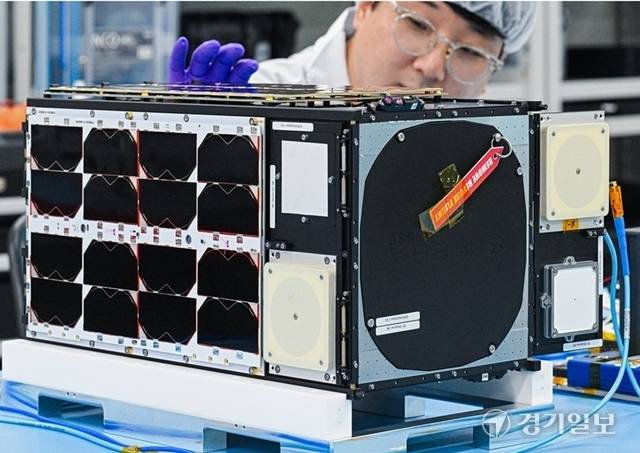Other news

What is Antenna Gain in Satellite Communications? (Explained simply)
Read more
Reflectarray Antennas for Small Satellites: From Concept to First Commercial Deployment
Read more
Launched on December 18, 2019, the EyeSat CubeSat, a project developed by the French Space Agency (CNES), embarked on a mission poised to deepen our understanding of space phenomena. This project was not just a CNES endeavor but also saw significant involvement from U-Space, a startup born from the very essence of the EyeSat mission. U-Space played a pivotal role in the operation of the satellite, bringing together innovative ideas and practical approaches to satellite management.
4 years later, EyesSat has not only fulfilled but surpassed its mission objectives, providing a wealth of astronomical data over an operational period that exceeded initial expectations.
As EyeSat’s mission draws to a close, the satellite is now preparing for re-entry into the Earth’s atmosphere. This culmination comes with a symbolic gesture — the delivery of its final image of Earth, a poignant reminder of the mission’s success and its connection to our home planet. It’s a fitting moment to reflect on the journey, the achievements, and the lessons learned from this pioneering satellite.
This article aims to provide an overview of EyeSat’s mission, from its launch to its final operations, highlighting key achievements and the technological advancements that were integral to its success, including the significant role played by Anywaves’ antennas in facilitating critical communication during the mission.

The EyeSat CubeSat was a landmark mission, representing a major achievement in the domain of academic-led space exploration initiatives. Launched on December 18, 2019, EyeSat was designed under the aegis of the JANUS initiative by CNES, which focuses on the engagement and practical education of engineering students through hands-on nanosatellite development projects. More than 250 students from prestigious institutions like ISAE-SUPAERO, IUT de Cachan, and ENAC embarked on this journey of designing, developing, and operating a 3U CubeSat.
U-Space, emerging from the academic roots of this project, played a crucial role in the operational phase of EyeSat. Their involvement was instrumental in bridging the gap between academic learning and real-world space mission operations. The mission’s trajectory and accomplishments, bolstered by U-Space’s operational expertise, stand as a testament to the robust design of EyeSat and the effectiveness of the collaborative educational framework established by CNES, its academic partners, and industry contributors.
EyeSat’s primary scientific mandate was to engage in the astrophysical study of the zodiacal light and the Milky Way’s interstellar medium. The zodiacal light, a diffuse luminescence caused by the scattering of sunlight by interplanetary dust, provides critical information about the distribution and properties of dust particles in the solar system. EyeSat’s observations aimed to refine our understanding of this phenomenon, which has implications for both solar system studies and cosmology.
Additionally, EyeSat sought to image the interstellar medium of the Milky Way. This matter, existing in the space between the stars, consists of gas in ionic, atomic, and molecular forms, as well as dust and cosmic rays. Understanding the interstellar medium is crucial for astronomy as it plays a significant role in star formation, galactic evolution, and the overall structure of the universe. The mission intended to capture images of the Milky Way in four spectral bands (red, green, blue, and near-infrared) with an estimated resolution of less than 2 degrees.
However, unfortunately, the premature wear of the satellite’s reaction wheels hindered the achievement of these scientific objectives. The reaction wheels are critical components for accurately orienting the satellite to target specific areas in space for observation. Their early degradation meant that the satellite could not consistently maintain the necessary orientation for detailed study and imaging of the zodiacal light and the Milky Way as initially planned. Despite this setback, the mission still provided valuable insights and data that contribute to our knowledge of space phenomena.
Indeed, beyond these scientific endeavors, EyeSat functioned as a platform for demonstrating new technologies. These included a Zynq-based onboard computer, a telemetry system operating in the X-band, and composite hinges among others. These technologies, mostly stemming from CNES’s research and development, were put to the test in the harsh environment of space, and the successful operation of these systems provided valuable insights and data that will inform the development of future satellites.
Throughout its mission, EyeSat has successfully acquired and transmitted voluminous data back to Earth. This data, facilitated by the high data rate transmission capabilities of the Anywaves X-band antennas, included not only high-resolution images of celestial phenomena but also detailed telemetry that offered insights into the CubeSat’s performance and the behavior of the onboard experiments.
The mission has also been a formidable pedagogical tool, with more than 200 students from top engineering schools and universities being integral to its development. Students were involved in every aspect of the mission, from the detailed design phase, through to environmental testing, and finally to operations in orbit. This practical involvement has helped to cultivate a new generation of aerospace engineers equipped with real-world experience in satellite development and operations.
As the project now nears its completion with EyeSat poised to re-enter the Earth’s atmosphere, the mission stands as a beacon of the potential that academic and research institutions hold in contributing to space exploration and technology. The rich legacy of data and the success of the mission’s technological demonstrations promise to have lasting impacts on the fields of space engineering and astrophysics.
In the arena of satellite communications, the choice and performance of antennas are pivotal, acting as the crucial link between spaceborne platforms and terrestrial operations. Anywaves’ bespoke antennas, which were integral to EyeSat, have played a paramount role in the mission’s scientific triumph and technological showcase. The collaboration between CNES and Anywaves exemplified how cutting-edge engineering could augment the capabilities of CubeSat missions.
Anywaves’ S-band antennas were designed to provide a robust communication link for telemetry, tracking, and command operations (TT&C). The flawless performance of these antennas ensured a persistent and stable line of communication with ground stations, essential for the dynamic operation of the CubeSat and for handling the downlink of operational data. With each pass of the nanosatellite over the ground station, the Anywaves S-band antennas facilitated a 100% connection rate, allowing for the continuous monitoring and control of the satellite’s functions.
In addition to TT&C, the scientific data retrieval was a crucial aspect of the mission. Here, the Anywaves X-band antennas were indispensable. The high data rate capability of these antennas allowed for the transmission of scientific payloads, including high-definition images, at unprecedented speeds for a nanosatellite platform. EyeSat was able to send back up to 10 images per pass, which enriched the scientific repository with valuable astrophysical data. This high-bandwidth communication capability was particularly critical for EyeSat’s mission to capture and analyze the zodiacal light and the interstellar medium, as it enabled the delivery of large sets of image data that required high-resolution capture.
The Anywaves antennas offered a compact, resilient, and highly efficient solution suited to the demanding conditions of space. Despite the miniature size of the CubeSat, these antennas delivered performance that rivaled larger systems on traditional satellites, showcasing the potential of miniaturized components in space applications.
Their resilience was demonstrated through the extended lifespan of the EyeSat mission. While initially projected to last for one year, the mission continued to deliver valuable data for over four years, largely due to the reliability of its communication systems. The antennas endured the space environment well beyond their expected operational period, with minimal degradation in performance, illustrating the quality and durability of Anywaves’ technology.
The success of EyeSat’s communication suite has broader implications for the future of space missions. Anywaves’ antennas have not only validated their designs but also opened the door for these technologies to be adopted in other aerospace projects, both academic and commercial. The data and insights gleaned from the operation of these antennas on EyeSat will inform the design of communication systems for future satellites, potentially setting new standards in the industry.
As the mission concludes, the role of Anywaves antennas stands out as a beacon of European innovation in space technology. The success of these components on EyeSat will echo in the aerospace sector, reinforcing the company’s position as a key player in satellite communication systems and contributing to the strengthening of Europe’s competitive edge in the burgeoning space market.
As EyeSat nears its controlled re-entry, the mission’s conclusion is both an end and a beginning. It marks the completion of a significant scientific endeavor and opens the door for further advancements in nanosatellite technologies. The synergy between CNES’s mission objectives and Anywaves’ antenna capabilities has not only supported a successful mission but has also set a precedent for future collaborative efforts between space agencies and industry partners.
The data collected by EyeSat will continue to be a valuable resource for the scientific community, providing insights into the dynamics of our solar system and beyond. Anywaves is proud to have been a part of this monumental project and remains committed to pushing the boundaries of space antenna technology for future missions.
As the industry looks forward to the next generation of nanosatellites, the contributions and the technological prowess demonstrated by EyeSat will undoubtedly serve as a cornerstone for future explorations.



If you have any question, we would be happy to help you out.